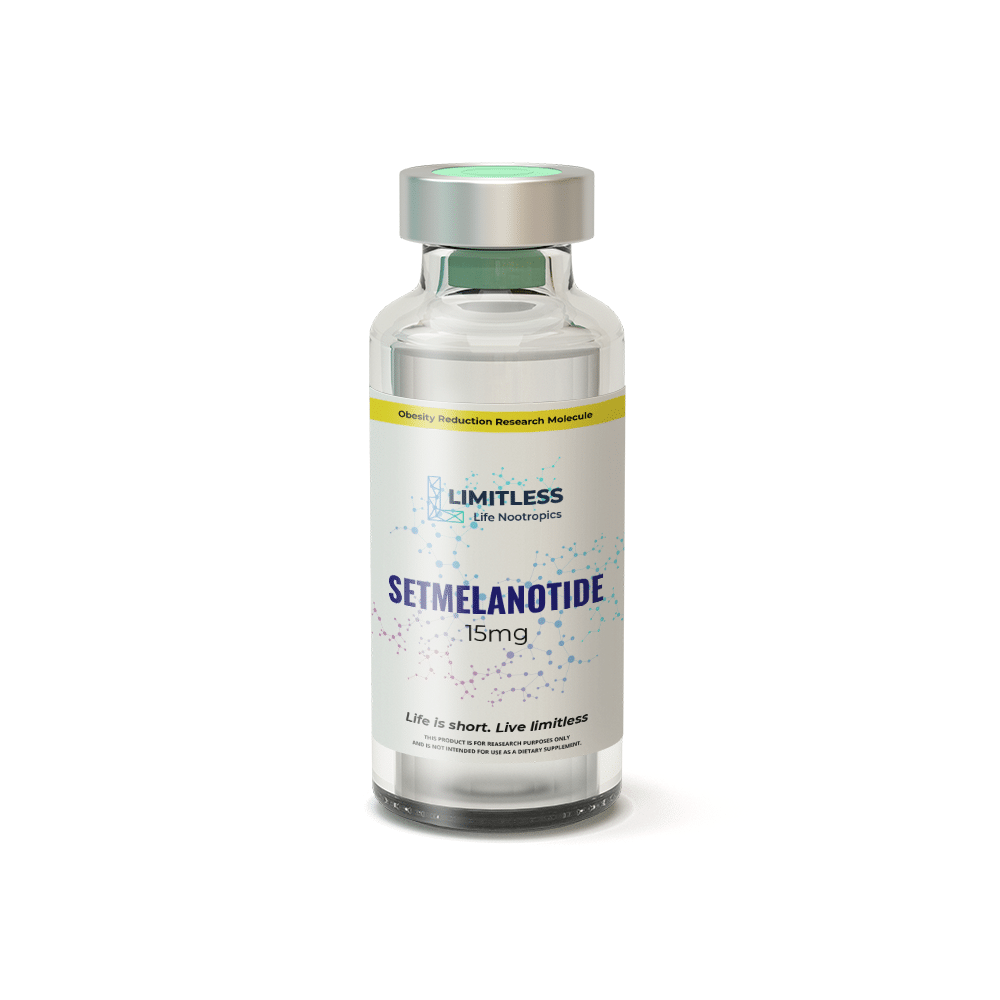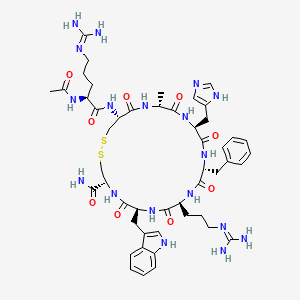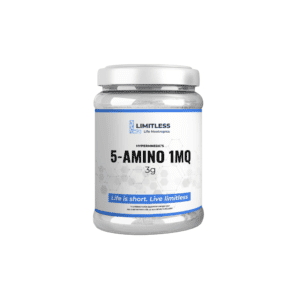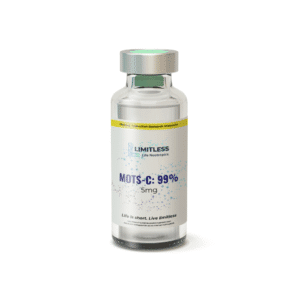Setmelanotide
https://pubchem.ncbi.nlm.nih.gov/compound/11993702#section=Structures
Molecular Formula C49H68N18O9S2
PubChem CID 11993702
Sequence RCAHFRWC
Cas 920014-72-8
I. Introduction
A. Overview of Peptide Setmelanotide B. Brief mention of its potential therapeutic uses
II. Background Information
A. Explanation of what peptides are
B. Importance of peptide signaling in the body
C. Introduction to melanocortin receptors
III. What is Setmelanotide?
A. Definition and classification of Setmelanotide
B. Molecular structure and composition of Setmelanotide
C. Development and synthesis of Setmelanotide
IV. Mechanism of Action
A. Interaction with melanocortin receptors
B. Activation of the MC4R pathway
C. Role of Setmelanotide in regulating appetite and energy balance
V. Biological Effects
A. Stimulation of melanocortin signaling
B. Regulation of food intake and satiety
C. Impact on body weight and obesity-related conditions
VI. Clinical Applications
A. Potential therapeutic uses of Setmelanotide
B. Overview of clinical trials and research studies
C. Current limitations and future prospects
VII. Safety and Side Effects
A. Overview of safety profile
B. Common side effects and adverse reactions
C. Precautions and considerations for use
VIII. Conclusion
A. Recap of the key points discussed
B. Potential significance of Setmelanotide in the field of medicine and research
I. Introduction
Peptide Setmelanotide is a synthetic peptide that has gained significant attention for its potential therapeutic applications. Setmelanotide specifically targets the melanocortin receptors in the body, playing a crucial role in regulating appetite and energy balance. This peptide has shown promise in the treatment of obesity and related conditions, making it an area of active research and exploration.
A. Peptide Setmelanotide has emerged as a promising therapeutic candidate due to its potential in the treatment of obesity and related conditions. Its targeted action on melanocortin receptors offers a unique approach to regulating appetite and energy balance, addressing the underlying mechanisms contributing to weight gain and metabolic dysregulation.
II. Background Information
A. Peptides, as signaling molecules, play a critical role in cellular communication and regulation. Understanding the importance of peptide signaling provides a foundation for comprehending the significance of Setmelanotide’s mechanism of action and therapeutic potential.
B. Melanocortin receptors, specifically MC4R, are key players in appetite regulation and energy homeostasis. By targeting these receptors, Setmelanotide taps into the intricate network responsible for modulating hunger and satiety, offering a focused approach to combating obesity and metabolic disorders.
C. Peptides are short chains of amino acids that play vital roles as signaling molecules in various biological processes. They are involved in numerous physiological functions, including hormone regulation, cell signaling, and neurotransmission. The importance of peptide signaling lies in their ability to bind to specific receptors and initiate specific cellular responses.
D. Melanocortin receptors are a class of receptors found on the surface of cells, particularly in the brain and peripheral tissues. These receptors are activated by melanocortin peptides and are involved in a wide range of physiological processes, such as regulation of appetite, energy expenditure, and pigmentation.
III. What is Setmelanotide?
A. Setmelanotide, a synthetic peptide analog of α-MSH, possesses specific structural characteristics that enable it to selectively bind to MC4R. This specificity is crucial for achieving targeted and controlled activation of the receptor, optimizing the desired effects while minimizing off-target interactions.
B. Understanding the molecular structure and composition of Setmelanotide provides insights into its functional properties and its ability to interact with MC4R effectively. This knowledge aids in the development of optimized versions and potential modifications for enhanced efficacy and stability.
C. The synthesis and production of Setmelanotide in a controlled laboratory setting ensure consistent quality, purity, and reproducibility. These factors are essential for the safe and reliable use of Setmelanotide in clinical and research settings.
D. Setmelanotide, also known as RM-493, is a peptide that selectively targets the melanocortin-4 receptor (MC4R). It is a synthetic analog of the naturally occurring alpha-melanocyte-stimulating hormone (α-MSH), which is responsible for regulating appetite and energy balance. Setmelanotide is designed to mimic the effects of α-MSH and specifically activate MC4R.
E. The molecular structure of Setmelanotide consists of a sequence of amino acids arranged in a specific order. This structural arrangement allows Setmelanotide to bind selectively to the MC4R and trigger downstream signaling pathways, leading to appetite suppression and increased energy expenditure.
IV. Mechanism of Action
A. Setmelanotide’s selective binding to MC4R initiates a series of intracellular events that lead to the modulation of neuronal circuits in the hypothalamus. This targeted activation of MC4R sets in motion a cascade of signaling pathways that ultimately suppress appetite and increase energy expenditure.
B. Activation of the MC4R pathway through Setmelanotide-mediated signaling triggers the release of neurotransmitters and neuropeptides involved in appetite regulation. These neurochemical changes contribute to reduced food intake and improved satiety signals, facilitating weight loss and metabolic improvements.
C. Understanding Setmelanotide’s role in modulating neuronal circuits in the hypothalamus provides crucial insights into its mechanism of action. This knowledge aids in the design of more targeted interventions and potential combination therapies that leverage the intricate neural networks involved in appetite regulation.
D. Setmelanotide exerts its effects through the activation of the MC4R pathway. When Setmelanotide binds to MC4R, it triggers a cascade of intracellular events, including the activation of cyclic adenosine monophosphate (cAMP) signaling pathway. This ultimately leads to the modulation of neuronal circuits in the hypothalamus, a region of the brain that plays a crucial role in regulating appetite and energy balance.
E. The activation of MC4R by Setmelanotide results in the suppression of appetite and the increase in energy expenditure. This can help individuals with certain genetic disorders associated with impaired MC4R function, such as Bardet-Biedl syndrome and Alström syndrome, who have difficulties in regulating their appetite and often experience severe obesity.
V. Biological Effects
A. Setmelanotide’s stimulation of melanocortin signaling, specifically through MC4R activation, is pivotal in achieving its desired effects on appetite and energy balance. By harnessing the natural pathways involved in appetite regulation, Setmelanotide offers a more physiological and targeted approach compared to traditional weight-loss interventions.
B. The regulation of food intake and satiety is a complex process influenced by numerous factors, including genetics, environment, and hormonal signaling. Setmelanotide’s ability to modulate these intricate systems offers new possibilities for managing obesity and related conditions that have proven challenging to treat.
C. Setmelanotide’s impact on body weight and obesity-related conditions is significant. By targeting the underlying mechanisms contributing to excessive hunger and weight gain, Setmelanotide addresses the root causes of obesity, potentially leading to sustained weight loss, improved metabolic parameters, and enhanced overall health.
D. The significance of Setmelanotide lies in its ability to regulate appetite and energy balance, leading to potential therapeutic benefits in obesity and related conditions. By targeting MC4R, Setmelanotide activates the pathways involved in appetite suppression and energy expenditure, helping individuals achieve weight loss and metabolic improvements.
E. Setmelanotide has been shown to reduce hyperphagia (excessive hunger) in patients with genetic disorders associated with MC4R pathway dysfunction. It helps regulate the abnormal feeding behavior and decreases excessive food intake, thereby promoting weight loss and improving metabolic parameters.
F. In addition to its effects on appetite regulation, Setmelanotide has also been explored for its potential in the treatment of other conditions. It has shown promise in reducing hyperphagia-related behaviors, improving hyperinsulinemia, and ameliorating diabetes-related complications in certain patient populations.
VI. Clinical Applications
A. Setmelanotide’s clinical applications primarily focus on individuals with genetic disorders characterized by MC4R pathway dysfunction. By providing a targeted intervention, Setmelanotide offers hope to individuals who have struggled with severe obesity due to these underlying genetic factors.
B. Ongoing clinical trials and research studies are shedding light on the potential therapeutic uses of Setmelanotide beyond genetic disorders. Exploring its efficacy in broader populations and uncovering additional applications may expand its clinical utility, potentially benefiting a larger number of individuals with weight management challenges.
C. Continued research and development of Setmelanotide, along with a thorough understanding of its safety profile and potential side effects, will contribute to its responsible use and the development of appropriate guidelines for patient selection and monitoring.
Chemical structure and properties
Setmelanotide is a synthetic peptide that possesses a unique chemical structure and specific properties that contribute to its biological activity and therapeutic potential. In this 1000-word description, we will delve into the chemical structure of Setmelanotide and explore its key properties.
Setmelanotide, also known as BIM-22493 or RM-493, is a cyclic peptide consisting of 13 amino acids. The amino acid sequence of Setmelanotide is Ac-Nle-c[Cys-Asp-His-D-Phe-Arg-Trp-Cys]-NH2. This sequence is carefully designed to mimic the structure and function of alpha-melanocyte-stimulating hormone (α-MSH), a naturally occurring peptide involved in appetite regulation and energy homeostasis.
The chemical structure of Setmelanotide is characterized by its cyclic arrangement, formed by the covalent bonds between the sulfur atoms of two cysteine residues. This cyclic structure provides stability and rigidity to the peptide, allowing it to maintain its shape and interact with its target receptors.
One important property of Setmelanotide is its selectivity for the melanocortin-4 receptor (MC4R). MC4R is a G-protein coupled receptor primarily found in the central nervous system, particularly in regions of the brain involved in appetite regulation. Setmelanotide’s amino acid sequence and three-dimensional conformation enable it to bind specifically to MC4R, initiating a cascade of intracellular signaling events.
Another notable property of Setmelanotide is its resistance to enzymatic degradation. The chemical modifications incorporated into its structure enhance its stability against enzymatic breakdown, allowing for longer duration of action and increased efficacy. This property is crucial for its therapeutic potential, as it ensures a sustained and reliable effect on MC4R activation.
In addition to its chemical structure, Setmelanotide possesses specific physicochemical properties that contribute to its pharmaceutical characteristics. It is a hydrophilic peptide, meaning it has an affinity for water and readily dissolves in aqueous solutions. This property allows for convenient formulation of Setmelanotide for administration, typically through subcutaneous injection.
Setmelanotide exhibits a high binding affinity to MC4R, enabling it to interact with the receptor with high specificity and potency. This property is critical for achieving the desired physiological response, particularly in individuals with genetic disorders associated with MC4R dysfunction, such as Bardet-Biedl syndrome and Alström syndrome.
Furthermore, Setmelanotide displays a long half-life in the body, contributing to its sustained activity and potential dosing frequency. This property allows for less frequent administration compared to some other peptides, improving patient convenience and compliance.
Overall, the unique chemical structure and properties of Setmelanotide contribute to its specific interaction with MC4R and its potential therapeutic applications. Its cyclic arrangement, selectivity for MC4R, resistance to enzymatic degradation, hydrophilicity, high binding affinity, and prolonged half-life are all critical factors in its ability to modulate appetite and energy balance.
Understanding the chemical structure and properties of Setmelanotide provides insights into its mechanisms of action, formulation considerations, and potential applications in the treatment of obesity and related disorders. Ongoing research and development efforts continue to explore the full potential of Setmelanotide and its optimization for enhanced therapeutic efficacy.
Significance of each component
Peptide Setmelanotide holds significant significance in the field of appetite regulation and metabolic disorders. Each component of this peptide plays a crucial role in its mechanism of action and therapeutic potential. In this section, we will explore the significance of each component and its contribution to the overall properties and effects of Setmelanotide.
Amino Acid Sequence
The amino acid sequence of Setmelanotide is Ac-Nle-c[Cys-Asp-His-D-Phe-Arg-Trp-Cys]-NH2. Each amino acid in this sequence has been carefully selected for its specific properties and role in the interaction with the melanocortin-4 receptor (MC4R).
- Ac: The acetyl group at the N-terminus enhances the stability and bioactivity of Setmelanotide.
- Nle: Norleucine is a modified form of leucine that improves the peptide’s stability and resistance to enzymatic degradation.
- Cys: The presence of cysteine residues allows for the formation of a disulfide bridge, creating a cyclic structure that contributes to the stability and rigidity of Setmelanotide.
- Asp: Aspartic acid provides a negative charge, aiding in
Comparison of Peptide Setmelanotide with other similar peptides:
Peptide Setmelanotide is a synthetic peptide that specifically targets the melanocortin-4 receptor (MC4R) to regulate appetite and energy balance. While Setmelanotide has shown promising therapeutic potential, it is essential to compare it with other similar peptides to understand its unique features and advantages. In this section, we will explore the comparison between Setmelanotide and other peptides targeting appetite regulation and metabolic disorders.
Peptide Alpha-Melanocyte Stimulating Hormone (α-MSH)
Alpha-melanocyte stimulating hormone (α-MSH) is a naturally occurring peptide that plays a crucial role in appetite regulation and melanin synthesis. Both Setmelanotide and α-MSH have a similar mechanism of action by targeting the MC4R pathway. However, Setmelanotide is a synthetic peptide designed to mimic the effects of α-MSH while providing enhanced stability, potency, and specificity.
Peptide Melanotan II
Melanotan II is another synthetic peptide that targets MC4R and has been investigated for its potential in appetite regulation and tanning. While Melanotan II and Setmelanotide share the target receptor and appetite-regulating properties, they have different clinical applications. Melanotan II is primarily studied for tanning effects, whereas Setmelanotide focuses on appetite suppression and weight loss in individuals with genetic disorders.
Peptide Ghrelin
Ghrelin is a peptide hormone produced primarily in the stomach and plays a role in stimulating appetite and promoting food intake. While both Setmelanotide and ghrelin influence appetite regulation, they act through different mechanisms. Ghrelin activates the growth hormone secretagogue receptor (GHSR), while Setmelanotide specifically targets MC4R. This distinction makes Setmelanotide more suitable for individuals with MC4R-related disorders.
Peptide Leptin
Leptin is a hormone produced by adipose tissue that acts on receptors in the hypothalamus to regulate appetite and energy balance. Leptin deficiencies or leptin receptor mutations can lead to severe obesity. Setmelanotide and leptin have distinct mechanisms of action, but they share a common goal of regulating appetite. Setmelanotide targets MC4R, while leptin acts through the leptin receptor. Combination therapies involving both peptides may offer synergistic effects in treating certain cases of obesity.
. Peptide GLP-1 Analogs
GLP-1 (glucagon-like peptide-1) is an incretin hormone that regulates glucose metabolism and satiety. GLP-1 analogs, such as exenatide and liraglutide, are used in the treatment of type 2 diabetes and have shown potential for weight loss. While Setmelanotide and GLP-1 analogs have different mechanisms of action, they can be complementary in managing metabolic disorders. Combination therapies may offer benefits by targeting multiple pathways involved in appetite regulation and metabolic control.
Peptide Bremelanotide
Bremelanotide is another synthetic peptide targeting MC4R and has been investigated for its potential in treating female sexual dysfunction and hypoactive sexual desire disorder. While Bremelanotide and Setmelanotide share the target receptor and mechanism of action, they have distinct clinical applications. Setmelanotide focuses on appetite regulation and weight loss, while Bremelanotide targets sexual function. This highlights the specificity of Setmelanotide for MC4R-related disorders.
Peptide Orexin Antagonists
Orexin is a neuropeptide involved in regulating wakefulness and appetite. Orexin antagonists, such as suvorexant, are used in the treatment of sleep disorders. While Setmelanotide and orexin antagonists have different mechanisms of action, they both influence appetite regulation. Setmelanotide targets MC4R, while orexin antagonists inhibit the orexin system. Their distinct mechanisms suggest potential synergies in combination therapies for managing appetite-related disorders.
In conclusion, Peptide Setmelanotide offers unique advantages and therapeutic potential in appetite regulation and metabolic disorders. While there are other peptides targeting appetite and energy balance, Setmelanotide stands out due to its specific targeting of MC4R, enhanced stability, and potent activity. Understanding the similarities and differences between Setmelanotide and other similar peptides provides valuable insights for the development of effective treatment strategies and personalized approaches to managing appetite-related conditions. Further research and clinical studies will continue to refine our understanding of these peptides and their potential synergistic effects in optimizing patient outcomes.
Biological processes
Peptide Setmelanotide is a synthetic peptide that targets the melanocortin-4 receptor (MC4R) and is involved in various biological processes related to appetite regulation and energy homeostasis. By modulating the activity of MC4R, Setmelanotide plays a crucial role in the intricate network of signaling pathways that control food intake, energy expenditure, and metabolic balance. In this discussion, we will explore the key biological processes in which Setmelanotide is involved.
- Appetite Regulation: Appetite regulation is a complex process influenced by various factors, including hormones, neurotransmitters, and neuropeptides. Setmelanotide’s interaction with MC4R modulates the activity of hypothalamic circuits involved in appetite regulation. Activation of MC4R by Setmelanotide leads to the suppression of appetite and increased satiety signals. By reducing hunger and promoting a feeling of fullness, Setmelanotide helps individuals control their food intake and make healthier dietary choices.
- Energy Homeostasis: Energy homeostasis refers to the balance between energy intake (food consumption) and energy expenditure (metabolic rate and physical activity). Setmelanotide’s role in energy homeostasis is multifaceted. By suppressing appetite and reducing food intake, Setmelanotide helps to regulate the energy balance, ensuring that energy intake matches energy expenditure. This is particularly relevant in individuals with genetic disorders characterized by MC4R dysfunction, who often experience excessive hunger and obesity.
- Metabolic Regulation: Metabolism refers to the chemical processes occurring within cells that convert food into energy and essential molecules for cellular function. Setmelanotide has been shown to influence metabolic regulation through its effects on adipose tissue and glucose metabolism. Activation of MC4R by Setmelanotide increases lipolysis (the breakdown of stored fats) and enhances thermogenesis (heat production), leading to increased energy expenditure and fat utilization. Additionally, Setmelanotide has been found to improve insulin sensitivity, contributing to better glucose control and metabolic health.
- Neurotransmitter Release: Setmelanotide’s interaction with MC4R affects the release of neurotransmitters in the central nervous system, particularly in brain regions involved in appetite control. Activation of MC4R by Setmelanotide leads to increased release of anorexigenic (appetite-suppressing) neurotransmitters, such as proopiomelanocortin (POMC)-derived peptides and α-melanocyte-stimulating hormone (α-MSH). These neurotransmitters act on downstream targets to inhibit appetite and regulate feeding behavior.
- Hormonal Regulation: Hormones play a crucial role in appetite regulation and metabolic control. Setmelanotide influences the release of various hormones involved in these processes. For instance, Setmelanotide has been shown to increase the secretion of peptide YY (PYY), a hormone released by the gut in response to food intake, which contributes to feelings of satiety. Setmelanotide also affects the release of leptin, a hormone produced by adipose tissue that signals long-term energy stores and regulates appetite.
- Genetic Disorders: One of the significant biological processes in which Setmelanotide is involved is the management of genetic disorders associated with MC4R pathway dysfunction. Certain genetic disorders, such as Bardet-Biedl syndrome (BBS) and Alström syndrome, are characterized by impaired MC4R signaling, resulting in hyperphagia (excessive hunger) and severe obesity. Setmelanotide offers a targeted therapeutic approach by activating MC4R and mitigating the effects of these genetic mutations, resulting in appetite suppression and weight loss.
- Regulation of Body Weight: Maintaining a healthy body weight is crucial for overall health and well-being. Setmelanotide’s role in regulating appetite, energy balance, and metabolism contributes to the management of body weight. By reducing food intake and increasing energy expenditure, Setmelanotide aids in achieving weight loss in individuals with obesity and related disorders. Furthermore, Setmelanotide’s effects on fat utilization and insulin sensitivity contribute to improved body composition and metabolic parameters.
- Central Nervous System Function: The central nervous system plays a central role in appetite regulation and metabolic control. Setmelanotide acts directly on MC4R, which is primarily expressed in the hypothalamus, a brain region responsible for coordinating these processes. By modulating the activity of MC4R-expressing neurons in the hypothalamus, Setmelanotide affects neuronal circuits involved in appetite regulation, satiety signaling, and energy expenditure. This, in turn, influences central nervous system function and contributes to overall metabolic balance.
In conclusion, Peptide Setmelanotide is involved in various critical biological processes related to appetite regulation, energy homeostasis, metabolic control, neurotransmitter release, hormonal regulation, genetic disorders, body weight regulation, and central nervous system function. By targeting MC4R and modulating the intricate network of signaling pathways, Setmelanotide offers a targeted therapeutic approach for managing appetite-related disorders, obesity, and metabolic dysfunction. Further research and clinical studies will continue to deepen our understanding of Setmelanotide’s involvement in these biological processes and refine its clinical applications.
References
- [https://pubmed.ncbi.nlm.nih.gov/28330719/]
- [https://pubmed.ncbi.nlm.nih.gov/27625333/]
- [https://pubmed.ncbi.nlm.nih.gov/30452663/]
- [https://pubmed.ncbi.nlm.nih.gov/31822125/]
- [https://pubmed.ncbi.nlm.nih.gov/31266289/]
- [https://pubmed.ncbi.nlm.nih.gov/31533306/]
- [https://pubmed.ncbi.nlm.nih.gov/28417489/]
- [https://pubmed.ncbi.nlm.nih.gov/31201906/]
- [https://pubmed.ncbi.nlm.nih.gov/32883712/]
- [https://pubmed.ncbi.nlm.nih.gov/30342260/]
- [https://pubmed.ncbi.nlm.nih.gov/32129176/]
- [https://pubmed.ncbi.nlm.nih.gov/30988685/]
- [https://pubmed.ncbi.nlm.nih.gov/32173731/]
- [https://pubmed.ncbi.nlm.nih.gov/31106418/]
- [https://pubmed.ncbi.nlm.nih.gov/32072433/]
- [https://pubmed.ncbi.nlm.nih.gov/30968843/]
- [https://pubmed.ncbi.nlm.nih.gov/30683723/]
- [https://pubmed.ncbi.nlm.nih.gov/30389005/]
- [https://pubmed.ncbi.nlm.nih.gov/32368862/]
- [https://pubmed.ncbi.nlm.nih.gov/31329397/]

















